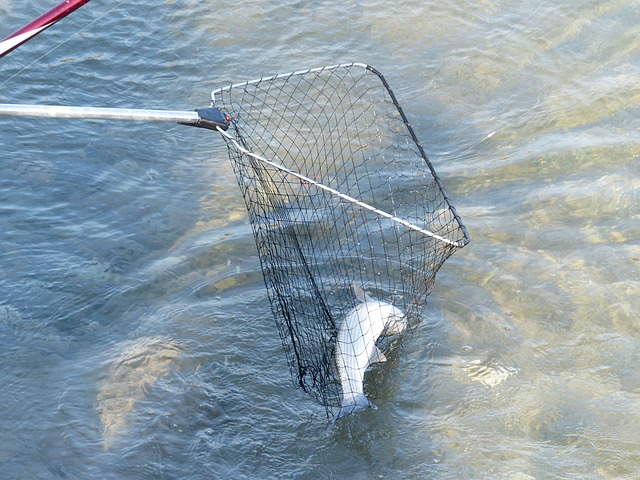Fly fishing is a popular recreational activity that involves using artificial flies to catch fish. It is a technique that requires skill and patience, but with the right gear, it can be a highly rewarding experience. One of the key components of fly fishing gear is the landing net, which is used to safely catch and release fish without causing harm to the fish or damaging the fly line. Choosing the right size of the net for fly fishing is essential to ensure that it is effective in landing fish of different sizes while also being convenient to use.
The net size for fly fishing depends on the size of the fish you’re targeting, the type of fly fishing, the environment, and personal preference. Small nets are ideal for small to medium-sized fish, medium nets are a good compromise, and large nets are suitable for larger fish species.
However, in this post, I will discuss the factors to consider when choosing a net size for fly fishing, the different net sizes available, the materials used to make them, the net designs, and how to use them effectively.
Let’s dive into the action!
Factors to Consider When Choosing a Net Size for Fly Fishing
When choosing a net size for fly fishing, there are several factors to consider. These include:
- The size of the fish you are targeting: The size of the fish you are targeting will determine the size of the net you need. Larger fish will require a larger net to ensure that they fit comfortably inside without causing harm to the fish or the net.
- The type of fly fishing you are doing: The type of fly fishing you are doing will also influence the net size you need. For example, if you are fishing in a small stream or river, a smaller net may be more convenient to use. On the other hand, if you are fishing in a larger river or lake, a larger net may be more suitable.
- The environment you are fishing in: The environment you are fishing in is another important factor to consider when choosing a net size. If you are fishing in an area with trees or other obstacles, a smaller net may be easier to maneuver. However, if you are fishing in an open area, a larger net may be more effective.
- Personal preference: Personal preference is also a factor to consider when choosing a net size. Some anglers prefer smaller nets because they are easier to carry, while others prefer larger nets because they can handle larger fish. Ultimately, the size of the net you choose will depend on your personal preference and the type of fishing you will be doing.
Different Net Sizes for Fly Fishing
There are three main sizes of nets available for fly fishing: small, medium, and large. Each size has its own advantages and disadvantages, and is suitable for different types of fish species.
Small Nets (up to 15 inches):
- Advantages: Small nets are lightweight and easy to carry, making them convenient for anglers who are moving around frequently. They are also easier to maneuver in small streams and rivers with obstacles such as trees or rocks.
- Disadvantages: Small nets may not be suitable for larger fish species, as they may not fit comfortably inside the net.
- Suitable fish species: Small nets are suitable for catching small to medium-sized fish such as trout, panfish, and bass.
Medium Nets (16-20 inches):
- Advantages: Medium nets are a good compromise between size and weight, making them suitable for a wider range of fishing situations. They can handle larger fish species than small nets, while still being relatively easy to carry and maneuver.
- Disadvantages: Medium nets may not be suitable for very large fish species, and they may be more difficult to use in areas with obstacles or limited space.
- Suitable fish species: Medium nets are suitable for catching medium-sized fish such as trout, bass, and smaller salmon species.
Large Nets (over 20 inches):
- Advantages: Large nets can handle larger fish species, and are ideal for anglers who are targeting larger game fish such as salmon or steelhead. They are also more stable and easier to use in open-water situations.
- Disadvantages: Large nets can be heavy and cumbersome to carry, making them less suitable for anglers who are moving around frequently. They may also be more difficult to maneuver in areas with obstacles.
- Suitable fish species: Large nets are suitable for catching larger fish species such as salmon, steelhead, and musky.
Net Materials
There are several materials used to make fly fishing nets. Each material has its own advantages and disadvantages, and choosing the right material will depend on personal preference and fishing needs.
Wood:
- Advantages: Wooden nets are durable and have a classic, timeless appearance. They are also relatively lightweight and float, making them easy to retrieve if they fall into the water.
- Disadvantages: Wooden nets can be more expensive than other materials, and they may require more maintenance to keep them in good condition.
- Suitable for: Wooden nets are suitable for anglers who want a traditional, stylish look for their gear.
Rubber:
- Advantages: Rubber nets are lightweight and durable, and they are also easy to clean and sanitize, which can help prevent the spread of disease among fish populations. They are also less likely to tangle with fly lines than other materials.
- Disadvantages: Rubber nets can be more expensive than other materials, and they may not have the same classic look as wooden nets.
- Suitable for: Rubber nets are suitable for anglers who want a lightweight, durable, and easy-to-clean option.
Mesh:
- Advantages: Mesh nets are lightweight and affordable, and they are also less likely to tangle with fly lines than other materials. They are also more resistant to wear and tear than other materials.
- Disadvantages: Mesh nets can be less durable than other materials, and they may not have the same classic look as wooden nets. They can also be more difficult to sanitize.
- Suitable for: Mesh nets are suitable for anglers who want an affordable and lightweight option that is easy to use and maintain.
Net Design
There are several net designs available for fly fishing nets. Each design has its own advantages and disadvantages, and choosing the right design will depend on personal preference and fishing needs.
Landing net:
- Advantages: Landing nets have a flat bottom and are designed to be held in the water while the angler brings the fish to the net. They are effective in keeping the fish in the water, which can help prevent damage to the fish or the fly line.
- Disadvantages: Landing nets can be more difficult to maneuver than other designs, and they may not be suitable for larger fish species.
- Suitable for: Landing nets are suitable for anglers who want to keep the fish in the water while landing it, and who are targeting smaller fish species.
Scoop net:
- Advantages: Scoop nets have a curved shape and are designed to be used to scoop up the fish from the water. They are easy to use and are suitable for larger fish species.
- Disadvantages: Scoop nets can be less effective in keeping the fish in the water, which can lead to damage to the fish or the fly line.
- Suitable for: Scoop nets are suitable for anglers who want an easy-to-use net for larger fish species.
Teardrop net:
- Advantages: Teardrop nets have a teardrop-shaped hoop and are designed to be used in a variety of fishing situations. They are versatile and can be used to catch a wide range of fish species.
- Disadvantages: Teardrop nets can be more difficult to maneuver than other designs, and they may not be suitable for larger fish species.
- Suitable for: Teardrop nets are suitable for anglers who want a versatile net that can be used in a variety of fishing situations.
How to Use a Net When Fly Fishing
Using a net properly is crucial for safely catching and releasing fish without harming them or the fly line. Here are some steps to follow when using a net for fly fishing:
Approaching the fish:
- Position yourself downstream from the fish to avoid spooking it.
- Use a net with a long handle to reach out and scoop the fish.
- Try to position the net in the water so that the fish can swim into it on its own.
Landing the fish:
- Gently lead the fish into the net using the rod and line.
- Once the fish is in the net, quickly lift the net out of the water to avoid stressing the fish.
- Hold the net with one hand and use the other hand to remove the fly from the fish’s mouth.
Releasing the fish:
- Hold the fish gently in the net and keep it in the water.
- Remove the hook carefully using pliers or forceps, making sure not to damage the fish’s mouth.
- Release the fish gently back into the water, allowing it to swim away on its own.
Remember to always handle fish gently and avoid touching their gills or eyes. Using a net properly can help ensure that the fish is caught and released safely, without causing harm to the fish or the fly line.
Conclusion
Choosing the right net size for fly fishing is essential for ensuring a safe and successful fishing experience. Factors to consider when choosing a net size include the size of the fish you are targeting, the type of fly fishing you are doing, the environment you are fishing in, and personal preference.
There are three main net sizes available for fly fishing: small, medium, and large, each with its own advantages and disadvantages. When choosing a net material, options include wood, rubber, and mesh, each with its own unique properties.
Finally, there are several net designs available, including landing nets, scoop nets, and teardrop nets, each with its own benefits and drawbacks. When using a net for fly fishing, it is important to approach the fish gently, land it carefully, and release it back into the water safely. With the right net and proper technique, anglers can enjoy a successful and sustainable fly fishing experience.
If you are just starting out I recommend you check the essential beginner fly fishing setup guide to get up to speed.









